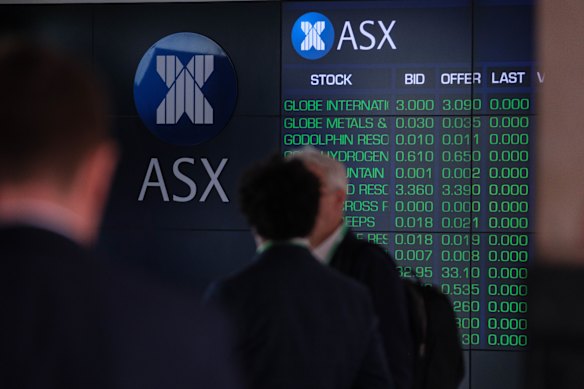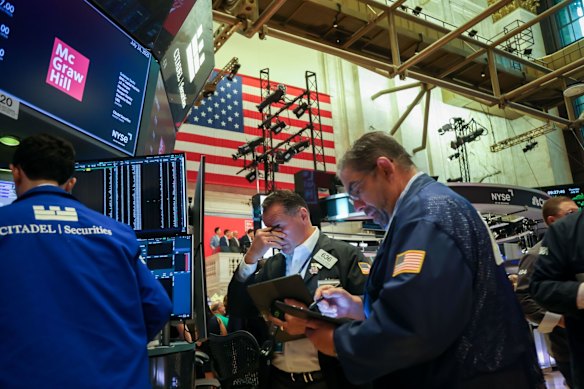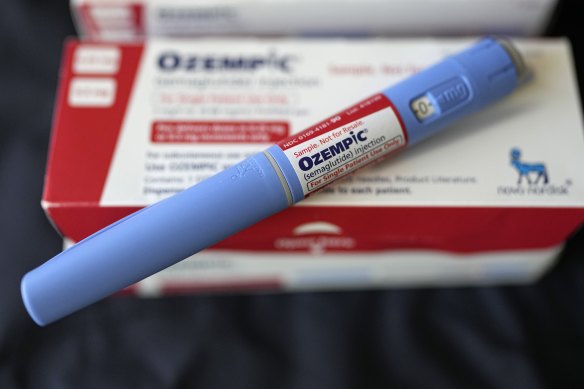- Updated
- Business
- Markets
- World markets
ASX nears all-time high as inflation figures open door for rate cut
By Staff reporter
Welcome to your five-minute recap of the trading day.
The numbers
The benchmark S&P/ASX 200 index on Wednesday came within less than a point of eclipsing its July 18 record for its highest close ever, rising 51.8 points, or 0.6 per cent, to finish at 8756.4. Three of the 11 sectors ended the session in the red.
In late afternoon trading, the index also moved less than four points away from breaking its intraday record of 8776.4, also set July 18. The broader All Ordinaries on Wednesday gained 48.7 points, or 0.5 per cent, to 9015.4.
The Australian dollar was buying US65.14¢, from US65.25¢ at 5pm on Tuesday.

The ASX welcomed the latest inflation figures.Credit: Oscar Colman
The lifters
Consumer and real estate stocks were the biggest movers. Woolworths (up 1.6 per cent), Coles (up 1.7 per cent), Endeavour Group (up 1.2 per cent) and Treasury Wine Estates (up 0.7) finished stronger.
JB Hi-Fi lifted 3.9 per cent, Wesfarmers was up 1.8 per cent and Harvey Norman added 1.6 per cent. Scentre Group added 1.9 per cent and Mirvac was up 2.7 per cent.
The big four banks were also stronger. NAB added 0.7 per cent, Westpac and Commonwealth Bank surged 1.6 per cent apiece, while ANZ Bank rose 1.3 per cent.
The laggards
The materials sector was flat (down 0.1 per cent) and mining stocks mixed. BHP slid 0.5 per cent, Rio Tinto dipped 0.1 per cent ahead of the release of its latest quarterly numbers out of London later on Wednesday, while Fortescue edged up 0.6 per cent.
Energy stocks were also mixed. Woodside lost 0.1 per cent even as oil prices bounced higher overnight after US President Donald Trump reiterated he may impose additional economic penalties on Russia unless a truce is reached with Ukraine. Ampol added 2.1 per cent, Yancoal lifted 1.1 per cent, and Santos shed 0.6 per cent.
Star Entertainment Group’s shares were trading 4.3 per cent lower after its bid to sell its half-stake in the money-losing Queens Wharf Brisbane entertainment complex for $53 million faltered.
In a statement to the ASX on Wednesday, the embattled casino operator said that based on the current status of discussions, it was “unlikely” the parties would be in a position to finalise sale documents by Thursday’s deadline.

Wall Street’s benchmark index had recorded six-straight winning sessions before Tuesday.Credit: Bloomberg
The lowdown
The Australian sharemarket extended gains after the Reserve Bank’s preferred measure of inflation fell to 2.7 per cent annually, adding to pressure on the central bank to deliver an August rate cut.
The ASX 200 was already in the green but rose another 36 points in the hour after the Australian Bureau of Statistics released its June quarter consumer price index readout.
That report showed that the Reserve Bank’s preferred inflation metric, trimmed mean inflation, was 2.7 per cent in the year to June 30, in line with expectations but down from 2.9 per cent in the year to March 31.
Headline inflation came in at 2.1 per cent, slightly under expectations of 2.2 per cent.
Betashares chief economist David Bassanese, one of a few economists who correctly predicted the central bank wouldn’t cut rates this month, said an August rate cut was now a “done deal”.
He predicted further cuts in November and February.
After the central bank’s last meeting, where it shocked the market by holding rates steady, governor Michele Bullock said the board was waiting to confirm whether inflation was still on track to sustainably reach 2.5 per cent.
Ahead of the ABS data release, money markets were pricing in a 95 per cent chance the Reserve would lower the cash rate to 3.6 per cent on August 12.
Today’s data was “consistent with monetary policy no longer needing to be restrictive”, said Luci Ellis, chief economist at Westpac, predicting a 25-basis-point cut at the Reserve Bank’s August 11-12 meeting. “We suspect that today’s data will come as something of a relief to the RBA.”
Market players will be tuning in for the Reserve Bank’s take on today’s inflation report when deputy governor Andrew Hauser speaks at a “fireside chat” event in Sydney on Thursday.
Elsewhere, investors are keeping watch on US President Donald Trump’s next tariff moves and several key catalysts that are on the horizon, such as the Fed rates decision and Friday’s US jobs report. Adding to the busy calendar, four tech giants are set to report earnings over a two-day stretch.
Overnight, the S&P 500 fell 0.3 per cent after setting all-time highs for six straight days. The Dow Jones dropped 204 points, and the Nasdaq composite sliced 0.4 per cent off its own record.
SoFi Technologies jumped 6.6 per cent, but Merck dropped 1.7 per cent and UPS sank 10.6 per cent following a torrent of profit reports from big US companies. They’re among the hundreds of companies telling investors this week how much they made during the spring, including nearly a third of the stocks in the S&P 500 index.
Treasury yields eased in the bond market as the Federal Reserve begins a two-day meeting where they will decide what to do with short-term interest rates. Despite angry lobbying from President Donald Trump for lower rates, which would give the economy a boost, the widespread expectation is that the Fed will wait for more data about how Trump’s tariffs are affecting inflation and the economy before making its next move.
The US economy has seemed to hold up OK so far despite the pressures of tariffs, though it does appear to be slowing.
One report on Tuesday said that US employers were advertising fewer job openings at the end of June than a month before, though still more than economists expected. A separate report said confidence rose among US consumers, but a measure of their expectations about the near term remains below the level that typically signals a recession ahead.
“Consumer confidence has stabilised since May, rebounding from April’s plunge, but remains below last year’s heady levels,” according to Stephanie Guichard, senior economist, global indicators, at The Conference Board.
China and the US agreed to continue their tariff pauses on each other, following a two-day meeting between trade officials in Stockholm. Negotiators had been working against an August 12 deadline, after which triple-digit tariffs were to resume. The US is currently taxing Chinese goods at 30 per cent and China is collecting 10 per cent on US products. Chinese stock indexes finished mixed ahead of the announcement.

US-listed shares of Ozempic maker Novo Nordisk, down more than 50 per cent over the past year, dipped again on Thursday.Credit: AP
Later this week, another deadline is looming on Friday for many of Trump’s proposed tariffs on other countries. And if that weren’t enough, several highly anticipated economic reports are also on the way, including the latest monthly update on the job market.
This jam-packed week could prove pivotal in determining whether the US sharemarket can keep climbing to more records or succumb to criticism that it’s grown too expensive following its quick leap in recent months.
Investors have also been punishing stocks of companies that have failed to meet expectations so far this reporting season.
Shares of Novo Nordisk that trade in the United States tumbled 21.8 per cent after the Danish company cut its forecast for sales growth this year, in part because of lower expectations for its Wegovy weight-loss drug because of high competition. It also named a new chief executive officer.
With AAP, AP, Bloomberg
The Market Recap newsletter is a wrap of the day’s trading. Get it each weekday afternoon.